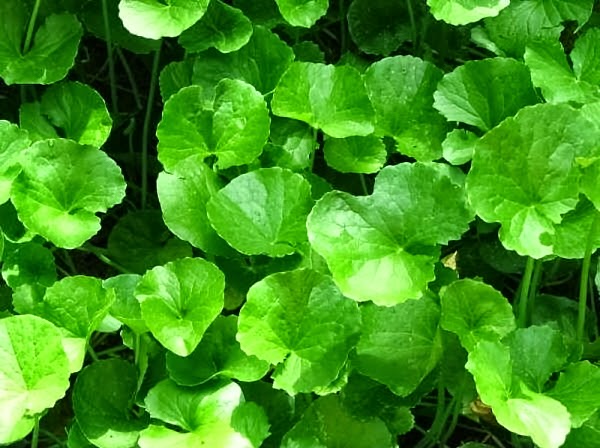The products you find online sometimes contain strange, unknown, and they sometimes even mysterious-sounding ingredients. One of those special ingredients is Asian Water Pennywort (Madukaparni). Curious what kind of special plant this is? Then read on!
Other names for Asian Water Pennywort
In Sanskrit the plant is called Madukaparni. The Latin and botanical name for this plant is Centella Asiatica-Folium (Apiaceae). ‘Cente’ can be translated as development and ‘Asiatica’ is an adjective indicating that the plant originated in Asia. Development is literally and figuratively reflected in the plant: it never stops growing and is therefore always developing.
The word “navel” in the Dutch name can be explained by the shape of the leaf; there is a clear center, from which the veins depart to the edges of the leaf, similar to the lines of a navel.
In Dutch, the following alternative names for this plant are known: Hydrocatyle, Indian Waternavel and Asian Waternavel herb. But you can also encounter this plant under the names Gotu kola, Kula kudi, Indian Pennywort, Madukaparni or Manduka Parni (Sanskrit: मंडूकपर्णी) and Fo ti Tien. The latter is the Chinese name and it can be translated as ‘Elixir for a long life’.
Characteristics and growing area
The leaf of Asian Water Pennywort looks like the feet of a frog, but also like the cerebellum; a part of our brain. Asian Water Pennywort has also traditionally been said to contribute to the normal functioning of the nerves and nervous system. In addition, it is said to have a beneficial effect on blood circulation.
The plant is native to Southeast Asia, but today it grows in many warmer areas. Such as Oceania, New Guinea, South Africa, Madagascar, Japan, China and Iran. It is a ground cover and grows to about 20 inches tall. In addition, it is an easy plant to keep and is pickable all year round. In appearance and characteristics, the plant is somewhat similar to ragweed.
Asian water pennywort & Ayurveda
From Ayurvedic teachings, the plant is characterized as suitable for all three doshas. This tonic has a lowering effect on Kapha and Pitta dosha.
Use of plant
The plant can be eaten and used as a salad or added to various (rice) dishes, curries or mixed with fruit in a delicious smoothie. You can also make juice from the leaves. These have a strong aroma.
Good for your skin
Asian water pennywort is a tonic for the skin and supports the skin’s ability to repair itself. Asian Waterbeetle is used externally for wounds, skin problems and cellulitis.
Ayurvedic tonic
In Ayurveda, Asian water pennywort is a rejuvenating and revitalizing herb. It is used to sharpen the mind, increasing attention span and ability to concentrate.
External use
Asian water pennywort use in homemade ointment or creams for skin care
Herbal tea
– Pour 1 to 2 teaspoons of water pennywort into a cup of boiling water
– Draw for 15 minutes
– Drink 3 times a day
In high doses, this herb has a stimulating and eroticizing effect. Add 30 grams of herb to half a liter of boiling water. Let it boil for at least 2 hours on a low heat with the lid on the pan. Strain it, add sugar or honey if necessary, and to start with, first take a small cup….










